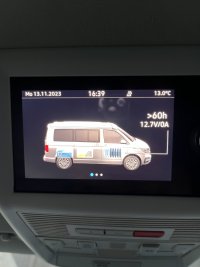G
Gazzer01
Update
Cube fuse (and 2 spares) arrived this morning (£4.95 each plus delivery)
1, I checked the voltage levels of the rear battery which was good and fully charged
2, Removed the blown 100A cube fuse by simply removing the positive cable from the front battery to the rear battery and replaced with a new fuse and then very attached the positive cable followed by carefully tightening the retaining nut.
3, Checked the control panel (See picture below) which was all good.
4, Started engine and ran for 15 minutes periodically checking control panel voltage and current
5, Set control panel to maximum charge and observed van revs and positive charge current increase.
6, As the batteries were already charged, observed the current decrease after a little while followed by a negative current draw (presumably as the starter battery took charge/equalised) for a while.
Conclusion
All now resolved thanks to @yossarian @WelshGas and will keep a continued eye when on site on EHU along with general driving. I remain curious if the fuse had a manufacture fault or there was a genuine current >100 A. Time will tell on that one.
Finally, Sharing your knowledge is truly gratefully appreciated and saved me a lot of time and effort. Thank you !!!!!!!

Cube fuse (and 2 spares) arrived this morning (£4.95 each plus delivery)
1, I checked the voltage levels of the rear battery which was good and fully charged
2, Removed the blown 100A cube fuse by simply removing the positive cable from the front battery to the rear battery and replaced with a new fuse and then very attached the positive cable followed by carefully tightening the retaining nut.
3, Checked the control panel (See picture below) which was all good.
4, Started engine and ran for 15 minutes periodically checking control panel voltage and current
5, Set control panel to maximum charge and observed van revs and positive charge current increase.
6, As the batteries were already charged, observed the current decrease after a little while followed by a negative current draw (presumably as the starter battery took charge/equalised) for a while.
Conclusion
All now resolved thanks to @yossarian @WelshGas and will keep a continued eye when on site on EHU along with general driving. I remain curious if the fuse had a manufacture fault or there was a genuine current >100 A. Time will tell on that one.
Finally, Sharing your knowledge is truly gratefully appreciated and saved me a lot of time and effort. Thank you !!!!!!!






















